Note (added Apr. 8, 2024): On initial publication this blog post incorrectly stated that Friday night lacked a flesh-and-blood DJ. There was one, in fact, by the pseudonym mcbaud300. When I was briefly in the ballroom, I didn’t see mcbaud300, but I did see a sign that led me to wrongly conclude the DJ was artificial intelligence. Below, in the apropos section of this post, I’ve added a photo, by Michael Citrak, of that sign, which read VIRTUAL DJ. That’s actually the name of a product that replaces physical DJ gear—such as turntables—with software, not something the replaces actual human DJs with software. Thanks Norwescon Discord for the corrections.
On Fri. Mar. 29, I attended Norwescon 46, the annual four-day science fiction convention nowadays based in Seattle (okay, SeaTac) that’s been running continuously since 1978. This was my first Norwescon — which I assume means North West Convention, though I’ve never seen that explicitly stated. Previously I’ve gone to a few other conventions: ConDFW (2009), Wiscon (2009), and Conflation (2014 or so).
Since I live in the Emerald City, I could bypass hotel room fees. And by limiting my participation to Friday only, I wasn’t diverting too much time away from work or toward crowds, which by nature repel introverts such as me. Before departing for the convention, I told myself to have a good attitude, to make the most of it, and — well, I had a good time, but it felt faintly elegiac. Like something that, if you look down to check your wristwatch too long, might not be there when you look back up.
The Frequently Asked Questions explains what Norwescon is all about:
Norwescon is the Pacific Northwest’s premier science fiction and fantasy convention and one of the largest regional science fiction and fantasy conventions in the United States. While maintaining a primarily literary focus, Norwescon is large enough to provide a venue for many of the other aspects of science fiction and fantasy and the interests of its fans such as anime, costuming, art, gaming, and much, much more.
Norwescon features hundreds of hours of panel programming, over 200 panelists specializing in fantasy, science fiction, horror, science, and more, the Philip K. Dick Awards, a 6,000+ square-foot Dealers’ Room, Writers’ Workshops, a full masquerade, an art show, dances, and more!
In the early afternoon, I parked by one of the far walls of the overpriced, crammed DoubleTree guest lot and started hiking on foot to the hotel. Long before I reached the lobby, it seemed the science fiction convention had already begun, outright, straight up in my face. Yes, right there in the parking lot. Where I was confronted with —
The Knightscope autonomous security robot
My surprise halted me. Recovering, I snapped two photos:
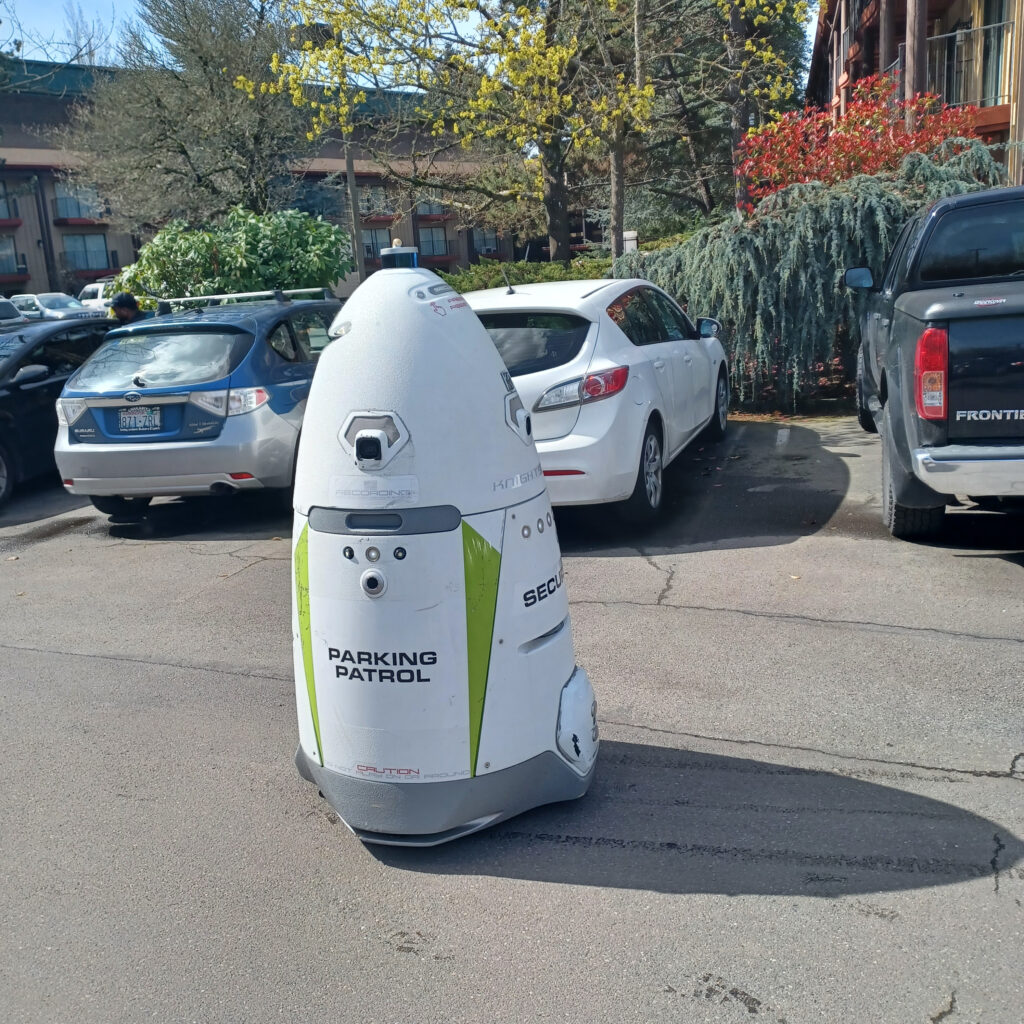

At first I was quite confused, thinking this was some Doctor Who Dalek-esque creation of the convention’s. But I soon confirmed it’s the hotel’s, and in fact, the hotel has been using the Knightscope for several years. The convention staffer I spoke with seemed unperturbed by the strange device, or perhaps resigned to it, trailing off his discussion of the subject matter …
In my photos, it looks stupid and harmless, comical even — like a big inflated balloon — but in real life, it’s actually kind of intimidating, as my video below hopefully shows. If I understand Knightscope correctly, the self-driving gizmo records surveillance film for optional review by humans later. Gives you those warm fuzzies that we’re all in this together, trusting one another to do our best and forge the optimal outcomes for our communities, right?
In a slogan asserting that crimefighting is impossible without such high-tech interventions, Knightscope’s website boasts that You need superhuman abilities to fight crime. Let’s be frank, law enforcement and security forces have long been keeping crime at the Goldilocks levels required to maintain whichever heinous balance of power the highest-ups prefer, a la cyberpunk novelist William Gibson’s character Ainsley Lowbeer. Fighting crime is something else entirely, and while outsourcing it to these robots might prevent automobile smash-and-grabs, that likely comes at the expense of us further forgetting how to use social support and shunning/approval to do so, because everyone can just be hyper-surveilled constantly and the unseen, promised Good Guys with superhuman abilities, far away somewhere, can help dispense justice on command for a fee. Turn your brain off; escape into adoration of the superhuman, the supertastic Knightscope!
Would there be actual superheros inside the hotel, with sincere hearts? Say, Phoenix Jones — real life crimefighters dressed up as superheroes? Didn’t the genre’s classic writers want readers to respond with this-worldly heroism, rather than robots replacing what’s left of people?
As I walked side by side with the Knightscope filming the thing, I really felt it was deliberately staring at me through its camera apertures. Maybe because I was blocking its vision. I don’t think the Knightscope carries any weapons, yet I couldn’t help but think of the Star Wars robot R2D2 and its Taser-style electric shock prod. About halfway into the video below, I start laughing, as does a couple nearby in a car, observing l’affaire robot. Then the couple starts their vehicle, ready to leave, kind of pinning me in from behind; the robot seized this moment to start coming at me from the front, shown in the video’s final seconds. I died then, and this is my replacement writing to you now.
High on panel: Managing unsolicited submissions in the era of AI

Once I entered the hotel proper, collected my badge, and saw a man hilariously dressed as Waldo from Where’s Waldo as well as a large Doctor Who Dalek prop carried by attendees, I headed for the panel titled Managing Unsolicited Submissions in the Era of AI. Four panelists: Podcastle editor Craig Jackson (moderator); Clarkesworld founder, editor, publisher Neil Clarke; Uncanny Magazine managing editor Monte Lin; The Magazine of Fantasy & Science Fiction publisher Gordon Van Gelder. The panel discussed exactly what its title says, a Turing Test problem that became major news in multiple outlets once Clarke opened up about it last year.
In other words, all these robots from without are assailing our science fiction — what can we do about it from within?
Below, I embed the seven-post thread I made on Bluesky loosely transcribing portions of the thought-provoking panel. Bluesky, you may know, is a Twitter-esque rival to the platform commandeered by Elon Musk; it has a smartphone app and no longer requires an invite code to join, though it still lacks DMs and support for video uploads. To read the seven posts directly on Bluesky, you can click through the below embeds, or follow this link, even if you lack a Bluesky account and don’t sign in, as with Twitter of yore.
As the panel concluded, I felt elated. Following the past few years of reading and writing science fiction, and doing investigative journalism and copywriting and philosophy research assistance — all of it writerly work, freelance jobs making up the majority of my mostly solitary life — suddenly, fresh topics I’ve been curious about were being discussed back and forth live among knowledgeable panelists and inquisitive audience members, all of them friendly, not competing to see who can be the most cruel at ripping off strangers’ heads or minimizing their every word, unlike much of social media and the offline realm. I’m not enough of a joiner to say I felt like I belonged or anything definitive like that — but I was really glad I came and looked forward to additional panels and events.

I resolved to check out Clarkesworld more often, then headed downstairs to the general area by the lobby, where my newfound excitement encompassed the various booths. There were H.P. Lovecraft-themed T-shirts for sale, a table with riddles written on wood with vendors offering clues, a huge supply of free books for the taking, and more. All at once these science fictional images, usually confined to my bookshelf, had bloomed all around me, left, right, up, everywhere I looked. I even asked some vendors research questions about miniature painting, related to my fiction-writing, and got some good leads. Again, a topic that had almost entirely existed in my lonely head for years was now in the flesh, and everyone cheerfully acted as if that were normal rather than the other way around.
Place of refuge losing luster
I ducked out for lunch, again seeing the Knightscope patrolling the parking lot. To the restaurant through hectic, smelly traffic. Something I ordered didn’t quite agree with me; my mood soured a smidge. Already I’d seen every vendor booth (though I forgot to check the art show, unfortunately). Hurrying back for another panel felt like a chore.
Wasn’t there something backward about all this? The last time H.P. Lovecraft wrote anything new was almost a hundred years ago. Isn’t there something more we can do about AI-spam besides write our Congressfools and beg the FTC chair, tactics that I myself do but that still feel dated next to real cutting-edge resistance? And that cumbersome Dalek prop, that robot-y Doctor Who creature attendees had carried through the hotel, was derived from a TV show that began more than a half century back. I assumed the Dalek lacked onboard electronics to theoretically counter the sleek, unapologetic Knightscope, which would probably vaporize it. Okay, not really. But all the same, though the unsolicited AI manuscripts panelists were certainly informed from their front-line battles with that particular problem, and led a truly interesting discussion, the convention as a whole was now feeling, to my postprandial self, like an enclave for out-of-touch museumgoers. There were very few in their Gen-Z twenties present, and when they were, it was typically because they were assisting their vendor parents.
From the start, I knew Norwescon wouldn’t be some best-in-class, outward-connecting headquarters of artistic resistance (is there such a place anywhere?). I wasn’t expecting earth-shattering revelations from any panelists. Why not just go home? Why couldn’t all — rather than merely some — of the panels be put online, with the audience able to type in questions, as mainstreamed during the years the United States called COVID-19 a federal public health emergency?
Because of the vitality, of course. Physical presence in such an environment, enjoying such conversations, festival like, brings its own energy surplus, or did initially. Now I just felt drained and was urging myself to keep going, a familiar self-flagellation from decades ago at university where I’d scolded myself to hurry, to make it to ̶p̶a̶n̶e̶l̶s̶ classes on time. I’m not sure why my mood had inverted. Maybe it was that, born in urban Texas, I’m unaccustomed to the obligations of participating in an interesting, mostly benign group-self — the convention, that perhaps I’d joined simply by being there — and unfairly demanded nonstop perfection from it. Maybe it was the sense of an unthinking eternal return, passing by the same booths over and over, the same unpurchased H.P. Lovecraft T-shirt over and over, has-been consumerist ants stuffed into an airless maze, the largely unacknowledged winds of change outside — not just Knightscope, but a collapsing trade economy, a birth strike and children insufficiently raised — steadily working on blowing down the insular walls of any type of convention anywhere.
Well, I’d only attended a single panel. Another might clarify things? I drove back to the hotel, seeing upon my return, industriously cruising past, the Knightscope.
Orbiting another panel: The rest of the world in space
The next panel I’d selected from the programming (also available here) was titled The rest of the world in space. A pair of space historians gave basic information about, and showed photos of, recent non-U.S. space missions. Below, I’ll embed my four Bluesky posts from the panel. Click through the embeds, or follow this link, to see the posts directly on Bluesky.
To me it felt a little like two gruff older guys showing you their favorite Wikipedia timeline. A chill way to ooh and aah over non-U.S. spaceships. It was good that one of them mentioned, albeit very briefly, the Belarusian dictator — without mentioning his name, Aleksandr Lukashenko — and his longstanding alliance with Putin as the real reason behind a Belarusian astronaut’s joint publicity photo with the Russians. I wish he’d said more, but he did not step out farther on the limb of the supposedly unspeakable, not during this panel anyhow.
When their presentation ended, I asked the panelists about the legal penalties (or not) for failing to de-orbit artificial satellites, and how the graveyard orbit fits into that framework (or not). Once again it was wonderful to talk with actual human beings highly knowledgeable about subjects I’m interested in, many of them underreported, yet powerfully impacting people, usually without their understanding. I regained some enthusiasm — tempered somewhat this time.
Briefly I met up with one of my fellows from Clarion West Writers Workshop class of 2008, Caren Gussoff, and we commiserated about the introvert struggle of attending a populous convention. We finished talking and she left; now I had a few final Friday hours to wander around, hoping to locate value.
Odds and ends
Exploring the hotel indoors, where windows were firmly shut and people were packed like proverbial sardines — an unofficial early estimate from Norwescon staff says 1,800+ people attended across the four days — I reckoned that one out of every eight or so individuals was masking, as in, against COVID and/or RSV and/or whatever this very recent bird flu in Texas is, something that jumped from birds to cattle to humans like a UFO from the microbial dimension. I was masking, as I do for packed-like-sardines settings such as schools and hospitals. It often appeared that more were using canes to help with walking than were using masks to help with preventing the spread of respiratory diseases.
I find it difficult to draw conclusions from the absence of widespread masking. In May 2023, the federal government declared the public health emergency over, and the CDC hasn’t collected as much COVID-19 data since, though their wastewater monitoring is interesting and as of this writing says COVID-19 viral activity is low countrywide. We might imagine scientists and science fictioneers hacking together their own experiments to audit or replicate data, bridging knowledge and questions from expert to novice levels and back again, testing out various hypotheses motivated by public interest and with complete transparency for public data, so that anyone interested could observe, doublecheck, and understand. Building something for sampling or imaging viral titer from the air, as scientist Justin Lee says, accurately assessing airborne transmission dynamics, ideally in real time. We might also imagine scientists and science fictioneers at the hotel bar, drinking to assuage the guilt and shame of a dissociated society that too often refuses and mocks effort, DIY innovation, and self-governance, even when those endeavor to keep us alive and buying H.P Lovecraft-themed swag as the Knighscope watches from outside a window.
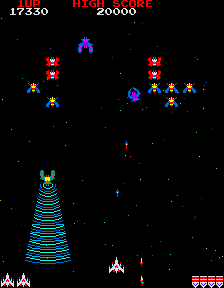
Easier challenges to conquer were the extraterrestrial enemies in Galaga, one of the many arcade games available that didn’t need quarters — I’m not sure if the games were part of the hotel or the convention, but I think the latter. Lighter fare.
As the night wore on, I checked out the ballroom. Looked like a carbon copy of the one I saw at Conflation in St. Louis circa 2014. It had a bar. It had a dance floor. It did not, however, have a human DJ [see correction at top of post—there was a human DJ, one by the pseudonym of mcbaud300—note added Apr. 8, 2024]. The DJ was some unseen robot — a sign touted this fact. The beautiful people danced and danced; for a few minutes, I watched from afar, before turning around to leave.
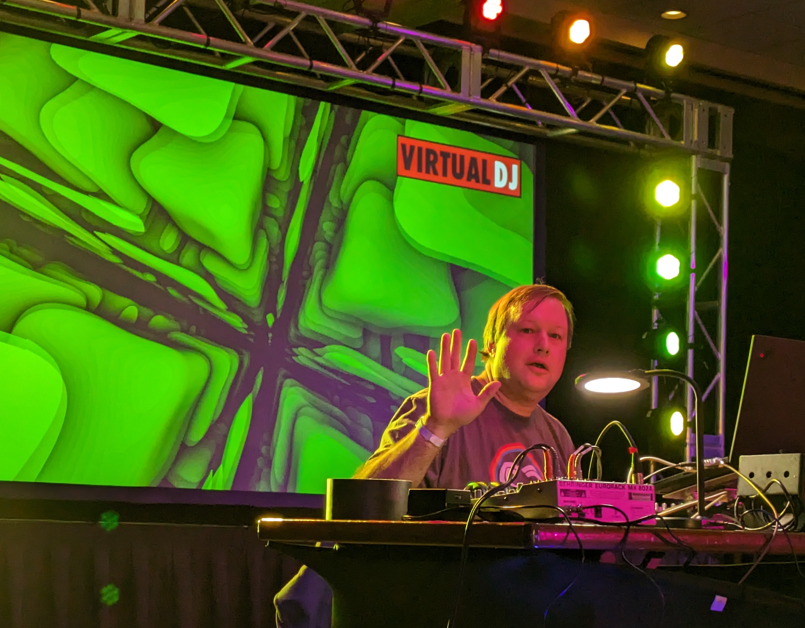
Likely I would have had more fun had I attended more panels, literary-focused ones, or participated in events specifically designed to facilitate socializing. There was a Speed Friending event I should have tried, where attendees converse one-on-one with a line of others for a few moments each, discussing interests, seeing if they might want to hang out more after the event. There were many rounds of charades I failed to attend as well, among them one on a Star Trek theme, which sounded really fun. Maybe some other time, some other life.
Concluding in the lounge
One area I enjoyed, and returned to often, was Norwescon’s lounge: essentially two hotel rooms, connected by a door, emptied out in favor of tables and chairs, free chips and soda, and other comforts. People — most, probably fifty years of age and up — gathered around in conversation, many already knowing each other. One told the heartbreaking story of how she’d lost her son due to a drunk driver. All the bureaucratic transportation department studies, good or bad, would turn to ash in the face of such a recounting. A while later, an older guy in a brown Jedi robe demonstrated the lightsaber he’d built, modeled after Luke Skywalker’s in the 1978 Star Wars Holiday Special. I of course gravely intoned: I see you have constructed a new lightsaber.
The lounge spawned a few random encounters with people my own age-ish, and as I got to know them a tad, I observed a certain pattern I’ve seen before. Namely, when they asked my background in science fiction and fantasy, and I began talking of my writing it during Clarion West Writers Workshop and in the subsequent few years, their attentive eyes focused on me — they seemed not a little impressed: Here we have an author on our hands! Then I explained that, though magazine acquisition editors were quite complimentary of my work, I never managed to sell any stories and partially as a result, transitioned to focusing on investigative journalism for roughly a decade, despite my druthers. That made their gaze drop, their hands fiddle with a phone or piece of candy. Then, once I said how recently, I’ve resumed fiction-writing, still without selling anything but with a better understanding of the world — now their eyes would look at me, again interested, albeit less so than at first. You can really feel an audience — even just one person in a casual conversation — drifting in and out of interest, reducing or increasing the amount of approval they’re expressing in reaction to your words.
Of course, at an Investigative Reporters and Editors conference, the reverse would happen: I’d talk of journalism publications to the lounge listener’s interest, then switch to discussing fiction-writing and at once get the silent you lost me, what’s that squirrel outside doing? While people naturally and rightfully have different interests, at Norwescon I couldn’t escape the sense of a terrible siloing taking place. Science fiction at this convention. Journalism at that convention. CDC COVID-19 policies over yonder. Belarusian dictator, trail off. Knightscope surveillance, trail off. Tactics beyond begging Congressfools, trail off. If no one faces up to that which determines our lives — governance, spy agencies, propaganda, the sharing or censorship of knowledge — then a shrug, for if all that remains for the triumph of evil is for good people to say they work so they deserve to just be happy, doormatting for injustices is (mostly) your right in the marketplace, even when the consequences harm everyone. The phallic toy weapons notwithstanding, inaction (or the milquetoast minimum) doesn’t really match the morals presented in the beloved science fiction and fantasy novels, but magically holds court nonetheless, all that dissociated guilt and shame and fear.
The fun conversations, the vitality between lonely souls sharing obscure interests, guarded by walls the outside of which includes a recent auto-coup attempt… With such threats largely unchallenged — yes, I know the news says it’s all under control, just as they did before the 2016 general election — conventions like Norwescon may have fewer and fewer attendees, no new blood. Every time I turn around in Seattle, another business closes, so will science fiction conventions suffer the same fading, fading away?
I asked above what science fiction could do from within to combat the robots assailing the genre from without. It’s as if there’s a monstrous, metalmade elephant in the room with no one’s face, and yet everyone’s face, attenuating anyone’s attempts to initiate efforts or escalate them into radical approaches. But the only superheroes within the hotel walls are us. As if the New Wave of Science Fiction never ended, I could have belted out Tell us more! when the space historian alluded to Lukashenko; someone could put together panels about tactics, mutual aid, strikes, boycotts, the provisioning of alternative governance; attendees in lounges could discuss ideas, and goals, and steps to get there for whatever problems — drunk drivers, out-of-control AI, space debris, or even the Justice Department’s endangerment of Sci-Hub and its founder Alexandra Elbakyan. Just going along as done in the past is robotic. Forging a human future requires not obeying the siloes — nor activism-scolding roommates, spouses, co-workers — but building bridges between concerns and perhaps even organizing new kinds of conventions, full of surprises.
Science fiction, involved in the future, a metaphorical realm where Star Trek’s Jean-Luc Picard does something about injustices other than sit on his hands gloating about don’t think too hard don’t care too much — all the threats the genre and the world face today, the roving surveillance bots, the AIs, the pandemics, the international spy agency subterfuge, even censorship of the genre’s Hugo Awards affecting big names such as Neil Gaiman and confirmed to have global political motives — they all have a science fictional flavor. Recall William Gibson’s remark to the effect that, for understanding the 21st century, reading 20th-century science fiction is a wonderful toolkit. But it doesn’t help much to merely understand, say, the chemical formula of some corporate poison if it completely kills you. To combat injustice, to protect ourselves, we have to cease existing primarily as escapist voyeurs, and actually take risks, actually open up the toolkit, actually use the tools.
I’m glad I went. Maybe someday I’ll go again, see what’s new, in the future.
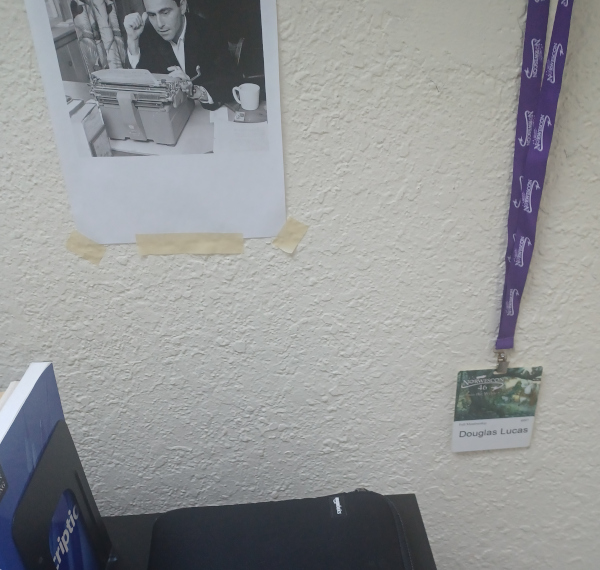


This blog post, Fading fun at Norwescon 46 on Friday … and the future?, by Douglas Lucas, is licensed under a Creative Commons Attribution-NonCommercial-ShareAlike 4.0 International License (summary). The license is based on the work at this URL: https://douglaslucas.com/blog/2024/04/02/fading-fun-norwescon46-friday-future/. You can find the full license (the legalese) here. To learn more about Creative Commons, I suggest this article and the Creative Commons Frequently Asked Questions. Please feel free to discuss this post in the comments section below, but if you’re seeking permissions beyond the scope of the license, or want to correspond with me about this post (or related topics) one on one, email me: dal@riseup.net. And gimme all your money!
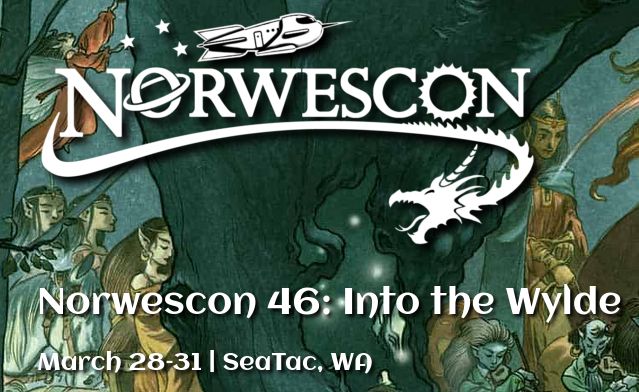
 Twitter:
Twitter:
2 comments ↓
Great post! I found the quotes from the AI panel particularly enlightening. Thanks!
Glad you were able to attend and found some value. The parking robot’s name is R2TREE2, by the way.
Leave a Comment